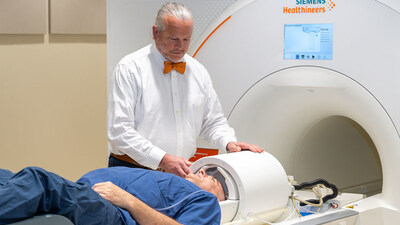Game changer: New 7T MRI elevates Auburn University research

AUBURN, Ala., Sept. 16, 2024 /PRNewswire/ — Gopikrishna Deshpande wants to see the brain in action.
How does information between billions of neurons flow within this cerebral superhighway? What functional details impact decision-making or even clinical disorders such as autism or Alzheimer’s?
Now, he can.
The recently approved $9 million Siemens MAGNETOM Terra.X 7 Tesla (7T) magnetic resonance imaging (MRI) scanner inside the Auburn University Neuroimaging Center takes researchers to places they’ve never been and provides them with detailed, ultra-high-resolution images they previously could not study. The world’s first field-installed, clinically approved parallel transmit 7T MRI scanner complements the center’s 3T scanner, part of its original equipment that’s still used today.
“3T scanners are standard in clinical practice today, and you get a fairly good view of what’s happening in the brain — but you miss a lot of the details,” said Deshpande, a professor of electrical and computer engineering, who specializes in signal/image processing. “Because the brain is such a complex organ with billions of neurons and trillions of connections, the devil is in the details. As researchers, we want to have as much detailed depiction, with high-resolution images, as possible.”
For Auburn, installing the powerful whole-body Terra.X 7 Tesla scanner was … a no-brainer.
“The university is sitting on a gold mine in terms of data and capabilities,” said Thomas Denney, director of the Auburn University Neuroimaging Center and the Mr. & Mrs. Bruce Donnellan & Family Endowed Professor in the Department of Electrical and Computer Engineering. “This machine puts us on the map in the MRI universe, and it allows us to play in a sandbox that we couldn’t play in before.”
Denney said updated scanners like this are fitted with parallel transmit technology and sodium imaging capability.
“With our old 7T, if we did an MRI scan of the brain in certain regions, you wouldn’t receive uniform coverage of the brain,” Denney said. “That’s because we had only one transmit channel — like a flashlight inside a large room with only one beam. By comparison, our new Terra.X 7 provides us with eight beams of light that illuminate the brain and provide a more uniform image. Sodium imaging technology is important because it can measure how much sodium is in your brain regionally and identify abnormalities.”
Denney noted that Auburn researchers, many whom have already utilized the center’s previous 7T and 3T equipment, will take advantage of this new avenue. Fresh research explorations already underway include:
- Meredith Reid, assistant professor in electrical and computer engineering, is exploring post-traumatic stress disorder biomarkers in senior adults via spectroscopy.
- Jennifer Robinson, professor in psychological sciences, compares brain connectivity between healthy populations and those with mental illness, focusing on cognition and emotions.
- Adil Bashir, associate professor in electrical and computer engineering, is studying muscle and brain energy production capacity on the cells and determining mitochondrial metabolic homeostasis using phosphorus spectroscopy.
- Doug Martin, director of the Scott-Ritchey Research Center and professor of anatomy, physiology and pharmacology at the College of Veterinary Medicine, is using MRI and spectroscopy to measure the effect of gene therapy for Tay-Sachs disease in animal models.
“I dreamed of building an MRI research program here at Auburn where large medical centers recognize our contributions,” Denney said. “Through research, Auburn University has moved the needle and more than exceeded my expectations. Since opening the Thomas Walter MRI Research Building in 2010, we’ve been able to double our staff. Those machines are great, but people are the ones who write research papers, and people are the ones who earn those research grants.”
People like Deshpande.
“MRI research has come a long way — and it will continue to evolve,” Deshpande said. “I’m proud that Auburn University is a leading player in this field as my colleagues and myself continue to explore the unexplored, explain the unexplained and provide impactful research to improve the quality of life for all.”
![]() View original content to download multimedia:https://www.prnewswire.com/news-releases/game-changer-new-7t-mri-elevates-auburn-university-research-302249091.html
View original content to download multimedia:https://www.prnewswire.com/news-releases/game-changer-new-7t-mri-elevates-auburn-university-research-302249091.html
SOURCE Auburn University



